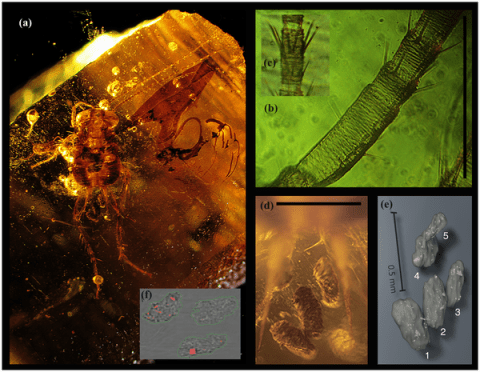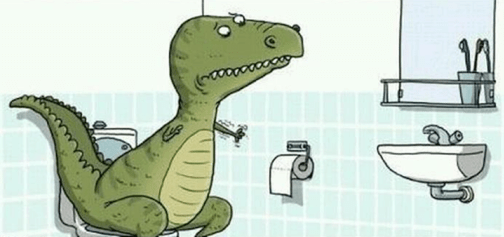Your poop or mine?
This was originally posted at: http://blogs.egu.eu/palaeoblog/?p=1023
Back in the Mesozoic, lavatories probably didn’t exist. In fact, dinosaurs and other animals were probably pretty poorly mannered and just pooped wherever they felt like. But what or who cleaned up after them? In modern biomes, poop is decomposed by insects and bacteria of all breeds, and actually forms quite an important part of energy flow within ecosystems. But was it the same million of years ago during the reign of the dinosaurs?
Imagine a natural world without decomposers. Carcasses would litter landscapes, and there’d be a neat smattering of faeces decorating everything like jam. Humans have adapted beyond this need for decomposers by creating the loo – dinosaurs weren’t so technologically efficient, and one can only imagine the issues T. rex would have trying to flush anyway.
Dung beetles are renowned for well, er, playing in the dirt, let’s say. They’re the most famous of the ‘dung cohorts’. But these weren’t around until the Jurassic period, some time after the initial ascent of dinosaurs. What about other insects? Cockroaches, particularly of the family Blattulidae (a name that somehow sounds like it’d be associated with poop), have been around since the Late Triassic, around the same that dinosaurs began to diversify.
New fossils of blattulids preserved in amber from Lebanon provide clues as to how such a symbiotic relationship between insects and dinosaurs would have worked. We’ve all seen Jurassic Park (right?), and all are probably aware of the preservational capabilities of amber – being entombed in an anaerobic shell can preserve exquisite detail as the natural processes of decomposition are halted before the animal is even dead. The amber from Lebanon is no exception.

Frozen in time for 120 million years, cockroaches have been found with coprolites, fossil dino dung, in the same pieces. It’s extraordinarily rare that we find such intimate associations between animals and their food (e.g., fish in a pterosaur stomach), and this would not be possible if it weren’t for the exceptional insights that amber offers. In fact, this mode of preservation is unique within the fossil record, and represents an entirely new type of trace fossil (behaviour in the fossil record).
So do the coprolites belong to dinosaurs? Well, they have quite a lot of woody material in them, stuff that’s already been half-digested, and this kind of diet has been recognised frequently in herbivorous dinosaurs, as they stripped leaves away and would probably often inadvertently nom a few twigs. The fact that they’ve been digested a bit sort of makes this trace fossil a bit inception-y – a trace within a trace: you have evidence of microbial decay on the wood preserved in a coprolite, with a cockroach within amber, which itself is the resinous fossilised sap of a tree. That’s pretty sweet as far as fossils go, especially for invertebrates..
Interestingly, the diversity of Blattulidae remained pretty low through the reign of the dinosaurs, and they stayed pretty ecologically conservative. This can probably be related to the diets of dinosaurs, which are generally thought to be pretty low quality, a long time before the rise of grasslands and muesli. As such, dino poop was probably quite nutritionally poor, not offering a bountiful energy supply to drive diversification in coprophages (animals that eat poop). Dung beetles, on the other hand, are related to the ascent of mammals, and are themselves quite a diverse group, and also rather specialised, as you might be aware of if you’ve ever seen (or smelt) one in real life. Might varying diets then in herbivores be a key driver of major insect lineages?
How this weaving web of symbiotic relationships between pooper and poop played out precisely is not discussed in the context of timing and relative diversity of all groups, but it certainly is an interesting dimension to consider when thinking about Mesozoic ecosystems. All too often we can get caught up in dinosaurs dinosaurs dinosaurs, when it’s the li’l critters that can provide some cool clues as to how they lived, and add just another tantalising glimpse into ancient ecosystems.
Reference
Vrsansky et al., (2013) Cockroaches probably cleaned up after dinosaurs, PLoS One, 8(12), e80560 (link)
